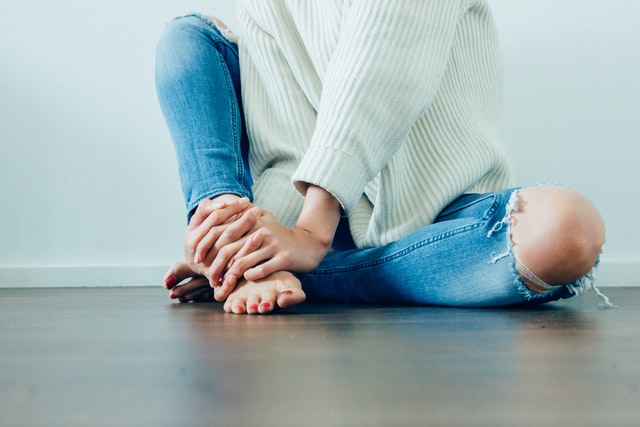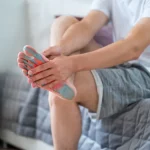
There are several kinds of heel pain. It can be due to a stress fracture, nerve irritation, tendonitis, or arthritis. But there is another kind of heel pain that’s also sometimes called heel spur and is the most common, which is Plantar Fasciitis.
Pain due to Plantar Fasciitis can be a level two, or it can really go up to a 10. It’s usually the most painful in the morning, when getting out of bed, and will start to ease after 15 to 30 minutes.
But then, as you go through the day, the pain can come back every so often. Like when you sit for at least 20 minutes and stand back up again, it can be as painful as when you just got out of bed.
Plantar Fasciitis occurs when the plantar fascia, the ligamentous band between the heel and the forefoot, becomes inflamed. Just imagine a fillet steak.
The white casing on the outside, which is hard to cut with a blunt knife, is like the fascia. People have something like that, about 2 to 4mm, that runs from the heel to the forefoot.
The plantar fascia helps stop the arch of your foot from dropping too far or flat on the ground.
While the navicular and other structures also help keep the arch of your foot, sometimes they get tired and put stress on the plantar fascia, which is the final thing that keeps your foot arch from dropping.
| Read also: Facts About Your Foot You Didn’t Know |
If your plantar fascia starts hurting, it means that there are more problems happening in your foot than just the plantar fascia.
Plantar Fasciitis occurs when sudden or direct trauma damages the plantar fascia or when there’s continuous stress or pressure placed on it for a long period of time.

Photo by Imani Bahati from Unsplash
These two causes usually happen during accidents, exercise, or doing sports, like football or track and field.
Some factors are known to cause Plantar Fasciitis to include:
- Activity – There’s a lot of pressure on the plantar fascia the more activities you do.
- Weight – There’s more pressure on the feet the more weight you carry.
- Hypermobility – When joints constantly move more than normal or further, the muscles work overtime to help stabilize it and could cause them to get fatigued, which then strains the plantar fascia.
- Increased time on your feet – If you’re constantly on your feet and constantly moving or carrying a load while on your feet, it causes a strain to the plantar fascia.
- Tight calves – Contrary to what most people know, calf muscles actually attach onto the back of your heel and go under the heel as well. Having tight calves can then pull on your plantar fascia and can make your foot have a premature heel rise, further straining the plantar fascia.
- Weak foot muscles – When the muscles in your foot get tired, they increase the strain on the plantar fascia.
- Tibialis Posterior Dysfunction – This occurs when the muscle at the back of the tibia (shin bone) gets fatigued and stops lifting your foot arch.
- Flat feet – Having a low foot arch can really strain and stretch the plantar fascia.
- High arches – While this is rarer, a foot that under pronates can also cause strain on the plantar fascia.
- Bad footwear – Good footwear helps a lot with lessening the pressure on the plantar fascia.
- Pregnancy – Weight gain during pregnancy adds stress to the plantar fascia.
While searching for heel pain on Google can help with assessment and diagnosis, going to a health professional can get you and your pain sorted out much more efficiently.
Just take note of when the pain started, how painful it is, have you done anything to ease the pain, like change footwear, and what work or daily activities do you do.
Treatments vary on a case to case basis. It is helpful to talk to a professional like the experts at Watsonia Podiatry so they can assist you properly.
It can be as simple as stretching or strengthening to doing massages. There are also more serious treatments, like orthotics, Shockwave Therapy, night splints, PRP or cortisone injections, Prolotherapy, acupuncture, compression, and Tiger Point Dry needling.
| Good Read: 5 Most Common Foot Injuries and How to Avoid Them |
Then there’s also surgery for the more serious cases. Activity modification, footwear changes, and taping may also be recommended. Treatments really depend on a person’s situation and it’s important to focus on what could help the most.
About The Author:
My name is Wahab. My interest is sharing different ideas and tips. I like to share ideas and as a result, I would be delighted to hear from you.




